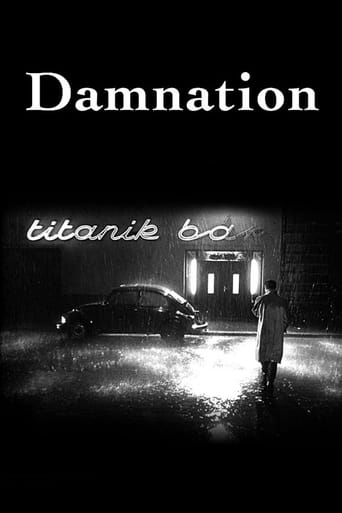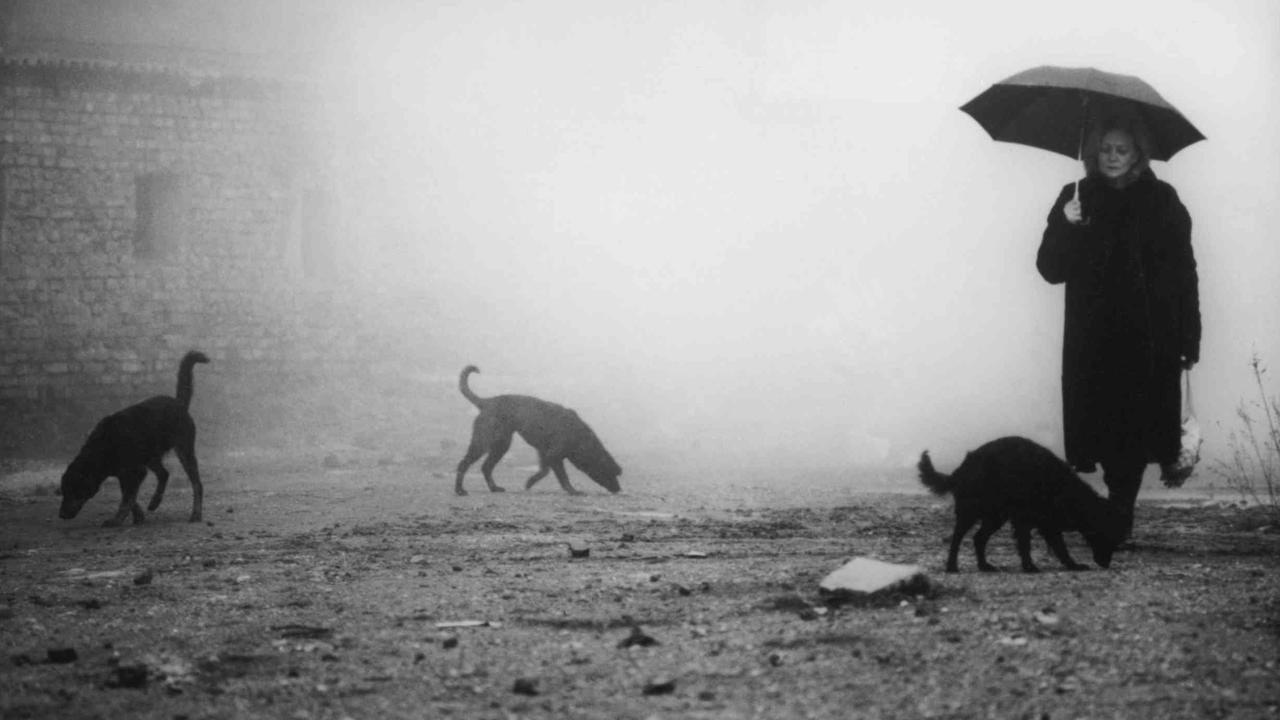aklcraigc
This is my second Bela Tarr movie, and I think I'm getting the idea here. The plot, what of it there is, concerns a local barfly who has become obsessed with a singer in a band which plays some of the bars he frequents, he drags the singer and her husband into some poorly defined subterfuge involving the picking up of a 'package' for some bar owner. Something goes not quite right with the scheme and the main character ends up reporting one or more of the other characters to the local police, the end. The whole thing is set in an unremittingly bleak Hungarian town where it's either raining or night (or both), once again Tarr seems to set up an interesting premise, then takes it nowhere. Every single shot is a long tracking shot, I mean, every single God dammed shot, in the end, the repetitious and unimaginative nature of the shots becomes wearing. No character development is attempted, the main character bores various other random characters to death with sub Nietzschean rants which should appeal to angst ridden teens. The movie picks up a little in the latter half with a local dance, as other reviewers have noted, little effort is made to synchronize the actions of the 'band' with the music, the locals drink and party looking like extras from a Bruegel painting. In the end, the movie simply has no emotional resonance, one is in no doubt that this is an attempt at art, but it's firmly in the 'toilet in the Tate Modern' category. All technique, no heart.
Cosmoeticadotcom
Bela Tarr became the most well known Hungarian director of films with the 1987 release of Damnation (Kárhozat). And, it's no wonder. While not an inarguably great film, it is certainly close, and a good case for its greatness can be made. More cogently, the film showed Tarr as a filmmaker who is singular, despite some manifest parallels to the work of Andrei Tarkovsky and Theo Angelopoulos. This 117 minute long black and white film, shown in a 1.66:1 aspect ratio is similar, in structure, to Tarkovsky's Stalker, and in pacing to Angelopoulos's films, although its visual imagery is straight out of the Italian Neo-Realism of the 1940s and 1950s.The film opens with a long slow pullback from a hot of a tramway of mining buckets moving back and forth, suspended over a bleak landscape, part of a small mining town. The sounds of the mechanized drudgery set the tone for the film, and as the camera pulls back from the buckets we see that we are inside an apartment, looking out the window at them. The camera then pulls even further back and around the silhouetted of a man's head. The slow reveal moves from almost a documentary-like feel to one of utter expressionism, as it finally ends, and we see a man shaving with a razor. This break, several minutes into the film, ends a shot that is almost a mirror image of the final shot of Michelangelo Antonioni's The Passenger. Antonioni, of course, is another filmmaker that Tarr is often compared to, and without a doubt, there are also similarities. Like the Italian cinematic master, Tarr's shot is, at once, the essence of simplicity, but also complexity and duplicity, for, while we start out with what seems an objective documentary shot of an industrial landscape, suspended in mid-air, it soon morphs into what seems to be a subjective shot of a character looking hopelessly out of a definite place. But, then, as the camera pulls back behind the putative eyeline of the silhouetted figure, the shot again becomes objective and omniscient, then switches to a more conventional shot of the main character, whom we learn is called Karrer (Miklós Székely), shaving. Then, we see, as the camera, again pans behind him, how his reflected image disappears behins the imposition of the darkness Karrer's body casts, until his face is swallowed by his body's darkness.The film is, despite its black and white, dark and sodden landscapes, amazingly beautiful. Rarely has the geography of the human mien been captured so wrenchingly, whether in the faces of the main characters, or in shots that seem to be social commentaries that underscore and play out against the main narrative, and featuring people who are never seen again. There is almost a clinical aspect to the way that Tarr pores over not only the human aspect but also the ruins of a small town. Yet, never is it technically clinical. The slow motion of camera movements away from the seeming center of the story is something that few filmmakers do. Yet Tarr does so, not only with ease, but a purposiveness that hints at the fact that the putative focus of that is just that, putative, and of no more genuine interest than a small portion of a derelicted building he turns his camera on.Damnation is a film that achieves greatness in many moments, but sometimes does not know when its points have all been made. The slight excesses of lingerance are the only down sides to a film that is a terrific document of the human creature; one that still has relevance to its viewers, as well as its viewed.
dbborroughs
Bela Tarr's mediation on interpersonal relationships (and perhaps, the end of the world). In a small town a man is obsessed with a singer in a night club. She's married but doesn't completely deflect his advances. Dark brooding tale filled with long takes seems to be taking place in another world or another time (perhaps it's an after life). It's a hypnotic trip (if this clicks with you about the nature of obsession and how we view ourselves (if not it's a pretentious and tedious exercise).I've read that director Bela Tarr insists that the film (as he insists about all his films) is a portrait of life as it is but I would be hard pressed to say that this is any sort of reality except perhaps a reality of the internal. The film's stark and beautiful black and white photography creates a world that seems forever in a mist or rain. It is a place like our own and yet different. People speak in ways that don't seem wholly normal. Verse is quoted and is the bible. No one speaks that way. Musicians play music but how they play doesn't quite match up with the music we hear. The mine carts that we see over head seem to be moving the damned to and from this place and not ore (indeed we never see either end of the line). Tarr says there is nothing allegorical or metaphoric implied or intended but I would argue that the film doesn't function as a straight narrative. Too much is off kilter, too much fails to connect for this to be real life. I'm not saying that the story of obsession, of a man doing what he feels he must to obtain the object of his desire doesn't work if it's taken as straight tale, it does, but at the same time the film becomes a battle with tedium. There becomes no reason for the film to run two hours, for the odd passages of dialog or the long takes. Frankly if the film is taken as the director intends it to be, then the film is a crashing bore and a failure on anything but a basic level. The film only works on some other level that isn't straight reporting, certainly the much used term 'apocalyptic' that I've read and heard connected to the film is inappropriate. Having been a creator of various things I know that sometimes the works we create change or become not what we intend. I understand that the creator of say a film is the one to ask what he intended but at the same time that doesn't mean what he intends is what is there on the screen. I think Tarr thinks he made one thing however I think he ended up with something else instead. I think as a film that is open to our own interpretation, being real world or not, the film is a masterpiece and a trip ripe with possibilities. I think as a straight tale of souls locked in a straight battle of possession it's a crashing bore filled with WTF moments. As something else of souls elsewhere or even inside of themselves it's a trip. See the film, take it for what it is, or what ever you take it to be and be carried away.
galensaysyes
...I think most people would be inclined to walk out. I might myself in a different mood. If the somnambulist from "The Cabinet of Dr. Caligari" made a movie, it would be something like this: sloooooooow, droooooooowsy, like roaming a rainy city by night, stopping for a while in an empty, smoky bar, though it doesn't matter whether you're inside or out, sitting or walking, asleep or awake, it's all the same. If you've ever been in that state and would care to see it reproduced in a film, this is that film, but I doubt whether it means much more.It certainly doesn't describe damnation. Sleepwalking in a mental and moral stupor makes a good metaphor for life, but surely it applies to the saved as well as the damned? This film is always stepping in and out of self-parody: we get the point of every shot and every speech in about one-sixth the time allowed; we can predict whenever a dog--the same dog?--is about to skulk into frame to cross the dreary street or the dreary waste; and the first of the lyric interludes that punctuate the story is a one-note, narcoleptic, androgynous chanson that sounds like Dietrich on Valium.The same director's "Satantango" opens with a ten-minute shot of cows coming out of a barn in the morning and dispersing through the barnyard. The film is seven hours long. I'm not pure enough in spirit for that, but this one I can about manage.


 AD
AD


